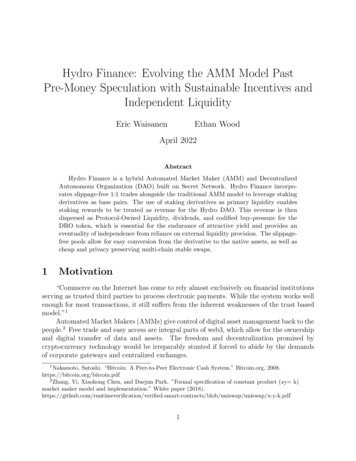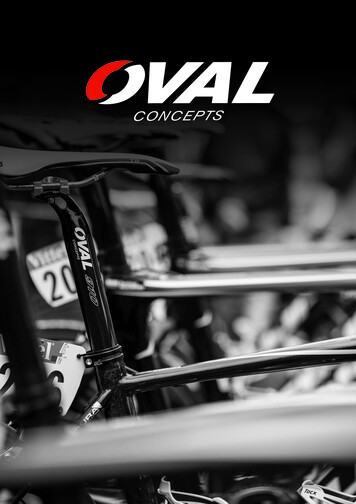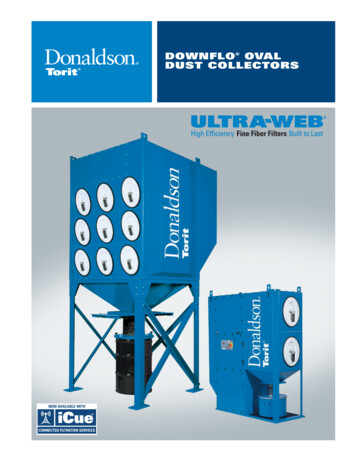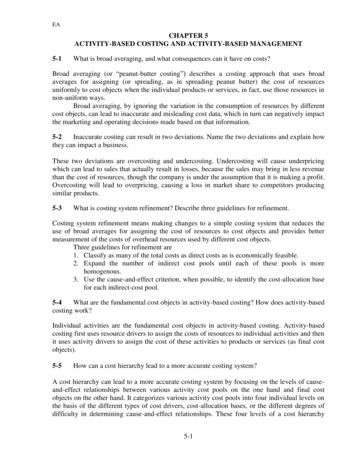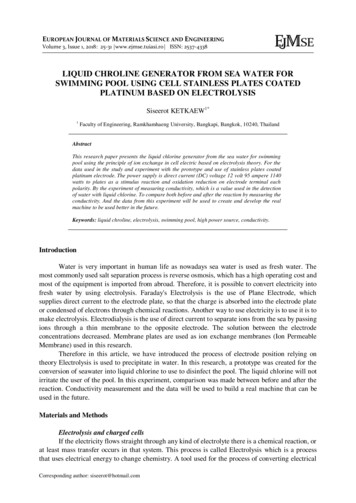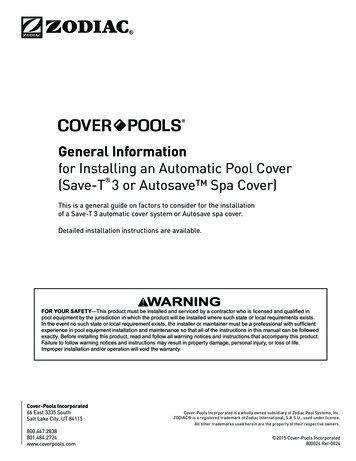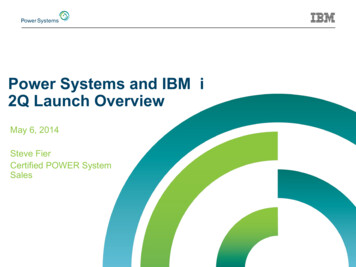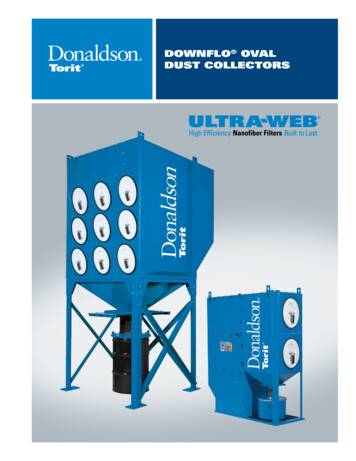
Transcription
TO THE STOREQUESTIONS? PROBLEMS?MISSING PARTS?Tel: 1-855-838-3888service@bestwaycorp.usFor FAQ, Manuals, Videos OrSpare Parts, Please Visitwww.bestwaycorp.comPOWER STEELTMOVAL POOLSOWNER’S MANUALwww.bestwaycorp.comVisit Bestway YouTube channelP-S-004948P-S-004948/21.0x28.5cm #15112 (客专藤条椭圆支架水池)JS-YF-2017-B-01471 18N-OEM-513/英
WARNINGsmooth out the bottomPut 1in. to 2in. water in the pool to cover the floor. Once pool floor is slightly covered, gently smooth out all wrinkles. Start in the center ofthe pool and work your way clockwise to the outside.BRUGERVEJLEDNINGDo not assemble on soft lawn. If you must assemble the pool on a soft surface, timber boards (not included) must be placed under the feetof the vertical supports to spread the load.2P-S-004948P-S-004948/21.0x28.5cm #15112 (客专藤条椭圆支架水池)JS-YF-2017-B-01471 18N-OEM-513/英
opening created should not allow the passage of a 4-inch diameter sphere.WARNINGSection II: Barrier LocationsBarriers should be located so as to prohibit permanent structures, equipment or similar objects from being used to climbthe barriers.IMPORTANT SAFETY INSTRUCTIONSRead and Follow All Safety Information and Instructions.Keep for future reference.Failure to follow these warnings andinstructions can result in serious injury or death to users,especially children.WARNINGWARNINGNO DIVING!Shallow water.PREVENTDROWNINGWARNINGPrevent DrowningNo DivingYou can be permanently injured.Only for outdoor use.Teach your children to swim.Never dive, jump, or slide into the pool.Adult supervision is always required.Parents should learn CPR.Never swim alone.Keep all electrical radios, speakers and other appliances away from the swimming pool.When you touch the filter, pump, or electrical parts, be sure the ground under your feet is “Bone Dry.”All electrical outlets should have a GFCI and connections should be a minimum of 5 feet (1.52 m) from the outsideperimeter of the wall of the pool. From 5–10 feet (1.52–3.05 m), there should be either a fixed connection (outlet box) ortwistlock connection with a GFCI.Connect power cords to a 3-wire grounding-type outlet only.Keep all breakable objects out of the pool area.Alcohol consumption and pool activities do not mix. Never allow anyone to swim, dive or slide under the influence of alcohol or drugs.Severe electrical shock could result if you install your pump or filter on a deck. The pump or filter could fall into the water, causingsevere shock or electrocution. Do not install on a deck or other surface at, above, or slightly below the top rail of the pool.Do not use the pool during severe weather conditions, i.e. electrical storms, tornadoes, etc.Be aware of overhead power lines when vacuuming your pool or using a telescoping pole.Do not allow diving, climbing, sitting, or standing on the top rails of the pools.Do not allow roughhousing and horseplay.Do not engage in extended breath holding activities underwater; you may black out and drown.Install a pool ladder(s) or staircase for entry and exit from the pool.Keep deck clean and clear of objects that may create a tripping hazard.Check regularly for signs of wear or loose bolts that could make the deck unsafe.Instruct pool users about the proper use of all pool ladder(s) and staircases.Face ladder going up or down.Allow only one person at a time on the ladder.Check all nuts and bolts regularly to ensure that the ladder stays sturdy.Remove or secure the ladder to prevent entry to pool when not in use.Please contact pool site dealer or manufacturer for additional safety signs if deemed necessary.For pool service, select a certified pool professional.Any equipment connected to the circulation systems shall be positioned so as to prevent their being used as a means ofaccess to the pool by young children.The installation must comply with the codes of the authority having jurisdiction and may require permits for building,plumbing electrical, zoning, etc.The pool shall be located a minimum distance of 6 ft (1.83 m) from any electrical receptacle.All 125 volt, 15 and 20 ampere receptacles located within 20 ft (6.0 m) of the pool shall be protected by a ground faultcircuit interrupter (GFCI). The 20 ft (6 m) distance is measured via the shortest straight line distance the supply cordwould follow without piercing a floor, wall, ceiling, doorway, window, or other permanent barrier.Prior to use of the pool, the installer shall affix all no diving signs and safety signs in accordance with installationinstructions so they can be easily visible.A barrier is necessary to provide protection against potential drowning and near drowning and that barriers are not asubstitute for the constant supervision of children.A list of emergency telephone numbers shall be posted, such as the nearest available police, fire, ambulance, and/orrescue unit. These numbers are to be kept near the telephone that is closest to the pool.Toys, chairs, tables, or similar objects that a young child could climb shall be at least 4 feet (1219 mm) from the pool.If deck is used by the installer, it will need to comply with APSP-8.Basic lifesaving equipment, including one of the following, shall be on hand at all times: a. A light, strong, rigid pole(shepherd’s crook) not less than 12 ft (3.66 m) long. b. A minimum ¼ in. (6 mm) diameter rope as long as 1½ times themaximum width of the pool or 50 feet (15.24 m), whichever is less, which has been firmly attached to a CoastGuard-approved ring buoy, or a similarly approved flotation devices.The swimming pool cover is not designated as a safety barrier.Please use artificial lighting during nighttime pool use, to illuminate all safety signs, ladders, steps, deck surfaces and walks.The pool is subject to wear and deterioration.If not maintained properly, certain types of excessive or accelerated deterioration can lead to failure of the pool structurethat might release large quantities of water that could cause bodily harm and property damage.The bottom of the pool shall be visible at all times from the outside perimeter of the pool.The installer of the vinyl liner shall affix on the original or replacement liner, or on the pool structure, all safety signs inaccordance with the manufacturer’s instructions.If you have a filter pump, refer to the pump’s manual for instructions.The ladder shall be located on a solid base and the ladder shall be installed per the ladder’s instructions.Publications are available that describe the risk of drowning, entrapment, and diving accidents.Available publications related to pool safety include the Association of Pool and Spa Professionals’ (APSP) bookletsentitled: The Sensible Way to Enjoy Your Aboveground/Onground Swimming Pool, Children Aren’t Waterproof, Pool andSpa Emergency Procedures for Infants and Children, Layers of Protection, and the latest published edition ofANSI/APSP-8 Model Barrier Code for Residential Swimming Pools, Spas, and Hot Tubs.You can break your neck and beparalyzed!Children under 5 are at highest risk for drowning.Closely watch children who are in or near this pool.WARNINGWARNINGElectrocution RiskStay away from drains & suction fittingsKeep all electrical lines, radios, speakers,and other electrical devices away frompool. Do not place pool near or underoverhead electrical lines.If drain or suction outlet cover is missing or broken, your hair, body,and jewelry can get sucked into drain. You could be held underwater & drown! Do not use pool if drain or suction outlet cover ismissing or broken.Watch children at all times.Prevent Young Children From Drowning:Install fencing or approved barrier around all sides of pool.State or local laws or codes may require fencing or other approved barriers.Check state or local laws and codes before setting up pool.Drowning occurs silently and quickly. Assign an adult to supervise pool and wear provided water watcher tag.Keep children in your direct sight when they are in or near pool and when you are filling and emptying pool.When searching for a missing child, check pool first, even if you think your child is in the house.Pool presents a drowning hazard even during filling and draining of the pool. Maintain constant supervision of childrenand do not remove any safety barriers until the pool is completely empty and stowed away.Refer to the list of barrier recommendations and guidelines as described in CPSC Publication No.362.Assign an adult to be responsible for watching children in the pool. Give this person a “water watcher” tag and ask thatthey wear it the entire time they are in charge of supervising children in the pool. If they need to leave for any reason,ask this person to pass the “water watcher” tag and the supervision responsibility to another adult.Locate pumps and filters in such a way that children cannot climb on them to gain access to pool.If you have a ladder, refer to the ladder's manual for instructions.If you have a pump, refer to the pump's manual for instructions.Prevent Young Children From Gaining Access to Pool:Remove pool ladders before leaving pool. Toddlers can climb ladder and get into pool.Position furniture away from pool so that children cannot climb and gain access to pool.When leaving pool, remove floats and toys from pool that might attract a child.Be Prepared to Respond to an Emergency:Keep a working phone and list of emergency numbers near pool.Become certified in cardiopulmonary resuscitation (CPR) so you can respond to an emergency.Electrocution Risk:Keep all electrical lines, radios, speakers, and other electrical devices away from pool.Do not place pool near or under overhead electrical lines.Suction Risk:Replacement pump should never exceed the maximum flow rate marked on the suction fitting.For further safety tips check out the following gwww.nspi.orgSafety Barrier Guidelines for Residential Swimming PoolSection I: Outdoor swimming poolAn outdoor swimming pool, including an inground, aboveground, or onground pool, hot tub, or spa, should be providedwith a barrier which complies with the following:1. The top of the barrier should be at least 48 inches above grade measured on the side of the barrier which facesaway from the swimming pool. The maximum vertical clearance between grade and the bottom of the barrier shouldbe 4 inches measured on the side of the barrier which faces away from the swimming pool. Where the top of thepool structure is above grade, such as an aboveground pool, the barrier may be at ground level, such as the poolstructure, or mounted on top of the pool structure. Where the barrier is mounted on top of the pool structure, themaximum vertical clearance between the top of the pool structure and the bottom of the barrier should be 4 inches.2. Openings in the barrier should not allow passage of a 4-inch diameter sphere.3. Solid barriers, which do not have openings, such as a masonry or stone wall, should not contain indentations orprotrusions except for normal construction tolerances and tooled masonry joints.4. Where the barrier is composed of horizontal and vertical members and the distance between the tops of thehorizontal members is less than 45 inches, the horizontal members should be located on the swimming pool side ofthe fence. Spacing between vertical members should not exceed 1-3/4 inches in width. Where there are decorativecutouts, spacing within the cutouts should not exceed 1-3/4 inches in width.5. Where the barrier is composed of horizontal and vertical members and the distance between the tops of thehorizontal members is 45 inches or more, spacing between vertical members should not exceed 4 inches. Wherethere are decorative cutouts, spacing within the cutouts should not exceed 1-3/4 inches in width.6. Maximum mesh size for chain link fences should not exceed 1-3/4 inch square unless the fence is provided withslats fastened at the top or the bottom which reduce the openings to no more than 1-3/4 inches.7. Where the barrier is composed of diagonal members, such as a lattice fence, the maximum opening formed by thediagonal members should be no more than 1-3/4 inches.8. Access gates to the pool should comply with Section I, Paragraphs 1 through 7,and should be equipped toaccommodate a locking device. Pedestrian access gates should open outward, away from the pool, and should beself-closing and have a self-latching device. Gates other than pedestrian access gates should have a self-latchingdevice. Where the release mechanism of the self-latching device is located less than 54 inches from the bottom ofthe gate, (a) the release mechanism should be located on the pool side of the gate at least 3 inches below the top ofthe gate and (b) the gate and barrier should have no opening greater than 1/2 inch within18 inches of the releasemechanism.9. Where a wall of a dwelling serves as part of the barrier, one of the following should apply:(a) All doors with direct access to the pool through that wall should be equipped with an alarm which produces anaudible warning when the door and its screen, if present, are opened. The alarm should sound continuously for aminimum of 30 seconds within 7 seconds after the door is opened. Alarms should meet there quirements of UL2017General-Purpose Signaling Devices and Systems, Section 77. The alarm should have a minimum sound pressurerating of 85 dBA at 10 feet and the sound of the alarm should be distinctive from other household sounds, such assmoke alarms, telephones, and door bells. The alarm should automatically reset under all conditions. The alarmshould be equipped with manual means, such as touchpads or switches, to temporarily deactivate the alarm for asingle opening of the door from either direction. Such deactivation should last for no more than 15 seconds. Thedeactivation touchpads or switches should be located at least 54 inches above the threshold of the door.(b) The pool should be equipped with a power safety cover which complies with ASTM F1346-91 listed below.(c) Other means of protection, such as self-closing doors with self-latching devices, are acceptable so long as thedegree of protection afforded is not less than the protection afforded by (a) or (b) described above.10. Where an aboveground pool structure is used as a barrier or where the barrier is mounted on top of the poolstructure, and the means of access is a ladder or steps, then (a) the ladder to the pool or steps should be capable ofbeing secured, locked or removed to prevent access, or (b) the ladder or steps should be surrounded by a barrierwhich meets Section I, Paragraphs 1 through 9. When the ladder or steps are secured, locked, or removed, anyFor additional safety information, see www.APSP.org.THIS PRODUCT IS COMPLIANT TO ANSI/ APSP 4 AMERICAN NATIONAL STANDARD FOR ABOVEGROUNDPOOLS / ONGROUND RESIDENTIAL SWIMMING POOLS & INTERNATIONAL SWIMMING POOL & SPA CODE(ISPSC)(Only for USA & only for pools with a water depth of more than 36in.(914mm))Please read carefully and keep for future referencePool Items:#B56622; #B56450;#B15112Before assembling your pool, please take a few minutes to check all the parts and become familiar with their position.3P-S-004948P-S-004948/21.0x28.5cm #15112 (客专藤条椭圆支架水池)JS-YF-2017-B-01471 18N-OEM-513/英
Components listNOTE: Some parts already have been installed on the pool.ABTop Rail BDFCE CETop Rail CECEFCCCDADEFECFTop Rail DT-Connector EGDCTop Rail AAECFDT-Connector FHNote: The installation drawing for the Top Rail and the T-Connector of 16ft. x 10ft. x 42in. (4.88m x 3.05m x 1.07m).Note: The installation drawing for the Top Rail and the T-Connector of 13ft.11in. x 8ft.2in. x39.5in.I(4.24m x 2.50m x 1.00m).Vertical Pool LegU-SupportFootingJKVertical Pool Leg Spring-loaded PinMCHOOSE THE CORRECT LOCATIONNOTE:The pool must be set up on a completely flat and level surface. Please do not install the pool if thesurface is inclined or sloped.Correct conditions to set up the pool: The selected location has to be capable of uniformly supporting the weight for the entire time the pool is installed,moreover the location must be flat and must be cleared of all objects and debris including stones and twigs. We recommend positioning the pool away from any objects children could use to climb into the pool.LU-Support Spring-loaded PinU-Support CapNNOTE: Position the pool near an adequate drainage system to deal with overflow or to discharge the pool.Incorrect conditions to set up the pool:O On uneven ground the pool may collapse causing serious personal injury and/or damage to personal property and willvoid the warranty and prevent any service claims. Sand should not be used to create a level base; the ground must be dug out if necessary.Top Rail Spring-Loaded PinLinerUnderwater adhesive repair patch Directly under overhead power lines or trees. Be sure the location does not contain underground utility pipes, lines orR Do not set up the pool on driveways, decks, platforms, gravel or asphalt surfaces. The selected location should be firmcables of any kind.PQenough to withstand the pressure of the water; mud, sand, soft / loose soil or tar are not suitable. Grass or other vegetation under the pool will die and may cause odors and slime to develop, therefore we recommendremoving all grass from the selected pool location.Hose AdaptorDrain Valve Cap Avoid areas prone to aggressive plant and weed species that may grow through the ground cloth or liner.StopperNOTE:Check with your local city council for by-laws relating to fencing, barriers, lighting and safety requirementsand ensure you comply with all laws.NO.#B56622#B56450#B1511213ft.11in. x 8ft.2in. x 39.5in.(4.24m x 2.50m x 1.00m)16ft. x 10ft. x 42in.(4.88m x 3.05m x 1.07m)16ft. x 10ft. x 42in.(4.88m x 3.05m x : If have a filter pump, refer to the pump’s manual for instructions.NOTE: The ladder must match the pool size and should be used only for entering and exiting the pool. It isforbidden to exceed the permitted payload of the ladder. Check regularly if the ladder is properly assembled.Installation1DCACCCDPART CECECCFECCFFD4P-S-004948P-S-004948/21.0x28.5cm #15112 (客专藤条椭圆支架水池)JS-YF-2017-B-01471 18N-OEM-513/英
3. Place the pool near an adequate drainage system to deal with overflow water and ensure the pool’s inlet A and3outlet B are correctly positioned to allow your filter pump to connect to a power source.extension power cords to power your pump.Note: Do not useATTENTION: Do not drag the pool on the ground, this can damage the pool.Filling Pool with WaterATTENTION: Do not leave pool unattended while filling with water1. Fill pool until water capacity is 90%, DO NOT OVERFILL as this could cause the pool to collapse. In times ofheavy rainfall you may need to empty some of the water to ensure the level is correct.2. When filling the pool is completed, check that the water is not collecting on any side to ensure the pool is level.IMPORTANT: If pool is not level, drain water and re-level ground by digging out. Never attempt tomove the pool with water in it, serious personal injury or damage to the pool may result.WARNING: Your pool may contain a great deal of pressure. If your pool has any bulge or uneven sideGthen the pool is not level, the sides may burst and the water may discharge suddenly causing serious personalinjury and/or damage to property.3. Check pool for any leaks at valves or seams, check ground cloth for any evident water loss. Do not addchemicals until this has been done.GGHNOTE: In the event of a leak, patch your pool using the underwater adhesive repair patch includedprovided. Refer to the FAQ’s for further information.0%30%90%70%40 Proper Water LevelINOTE:Drawings for illustration purposes only. May not reflect actual product. Not to scale.Pool MaintenanceIf you do not adhere to the maintenance guidelines below, your health might be at risk, especially that of your children.IIMPORTANT: If you don’t respect the ideal values of the water chemicals the PVC can be damaged andbecome discolor.The following table lists the sequence of the tests that should be carried out for the ideal values and possible actions.Regularly check the pH value and chlorine concentration weekly and adjust to the ideal values.TEST5IDEAL VALUESpH value7.4– 7.6Cyanuric acid30 – 50 ppmFree chlorine2 – 4 ppmChlorine compound0AlgaeNone visibleCalcium hardness200 – 400 ppmTo keep your pool clean:1. Contact your local pool supply shop for advice and purchase of chemicals and pH kits. One of the most importantfactors to increase the life of the liner is to keep continuously clean and healthy water. Please strictly follow theinstructions from professional technicians for the water treatment through the use of chemicals.2. Locate a bucket of water next to pool to clean users’ feet before entering pool.3. Cover the pool when not in use.4. Skim pool regularly to avoid settled dirt.5. Check and wash the filter cartridge regularly.6. Gently clean any scum from below the top ring with a clean cloth.7. Please be careful in case of rain water, kindly check that the water level is not higher than the expected. If so, YOUHAVE TO DISCHARGE THE EXCESS WATER.Proper maintenance can maximize the life of your pool.6During the season of use of the swimming pool, the filtration system must be necessarily put into service every day,enough time to assure at least a complete renewal of the volume of water.RepairCheck pool for any leaks from valves or seams, check the ground cloth for any evident water loss. Do not add chemicalsuntil this has been done.NOTE: In the event of a leak, patch your pool using the underwater adhesive repair patch included provided.1in. - 2in.2-5 cmDismantling1. Unscrew the drain valve cap on the outside of the pool counter clockwise and remove.2. Connect the adaptor to the hose and put the other end of the hose in the area where you are going to drain your pool.(Check local regulations for drainage by-laws).3. Screw the control ring of the hose adaptor clockwise onto the drain valve. The drain valve will be open and water willstart to drain automatically.ATTENTION: Water flow can be controlled with the control ring.4. When draining is finished, unscrew the control ring to close the valve.5. Disconnect the hose.6. Screw the cap back onto the drain valve.7. Air dry pool.ATTENTION: Do not leave the drained pool outside.Assembly of the Frame pool can be completed without tools.IMPORTANT: Bestway Inflatables will not be responsible for damage caused to the pool due tomishandling or failure to follow these instructions.1. Lay out all parts and check that you have the correct quantities as listed in the components list. If you aremissing any parts do not assemble the pool and contact Bestway Customers Service.2. Spread out the pool and make sure the pool is right side up; let it sit exposed to direct sunlight for 1 hour ormore so that the pool is more flexible during set up.5Storage and Winterization1. Please remove all the accessories and spare parts of the pool and store them clean and dry.2. Once pool is completely dry, sprinkle with talcum powder to prevent pool from sticking together, fold pool carefully. Ifpool is not completely dry, mold may result and will damage the pool liner.3. Store liner and accessories in a dry place with a moderate temperature between 5ºC / 41ºF and 38ºC / 100ºF.4. During the rainy season, pool and accessories should be stored as per above instructions also.5. Improper draining of the pool might cause serious personal injury and/or damage to personal property.6. We strongly recommend the pool is disassembled during the off season (winter months). Store in a dry location outof children’s reach.P-S-004948P-S-004948/21.0x28.5cm #15112 (客专藤条椭圆支架水池)JS-YF-2017-B-01471 18N-OEM-513/英
Limited BESTWAY Manufacturer’s WarrantyThe product you have purchased comes with a limited warranty. Bestway stands behind our quality guarantee and assures, through a replacement warranty, your product willbe free from manufacturer’s defects, the limited warranty is valid as follows:90 days from the original date of purchase.Please contact your Bestway After Sales Center before sending any documents. They will provide full instructions of what is needed for your claim. Bestway is not responsiblefor economic loss due to water or chemical costs and will not replace any products deemed to have been damaged due to negligence or used outside of the owner’s manualguidelines. To enact a warranty claim, this form must be completed and supplied with a copy of your receipt/purchase and photos of the defects to the Bestway After SalesCenter.Bestway’s warranty covers manufacturing defects discovered while unpacking the product or during use, as recommended within the user manual. This warranty applies only tothe product and must not have been modified by any 3rd parties. The product must be stored and handled in accordance with the technical recommendations.If a product is deemed to be defective by Bestway , the warranty covers the repair or replacement of the defective part only. Replacements and repairs don’t extend theduration of warranty. The original receipt/purchase invoice is required and will determine the start and the end dates of the warranty.Please choose the type of your pool:PLEASE HAVE THE FOLLOWING IMFORMATION ON HAND BEFORE CALLING OUR AFTER SALES SERVICE p/Postal Code:Fax:Country: US Canada E-mail:ORIGINAL PURCHASE DATE:RETAILER:POOL ITEM CODE:BATCH NUMBER:#BXXXXXBWSHFXXXXXXYYYY-MM-DDItem CodeBatch Number22’X52”Problem descriptionItem is torn / LeakingFaulty weldingOther (Please describe)Missing part (Please use the code for the missing part. This can be found in the owner's manual.)Faulty upper ringFaulty drain valveBestway does not warranty items which have been subject to: Improper or abnormal use Failure to follow the instructions as provided by Bestway Negligence Commercial use Accident Vandalism Terrorist Activity Improper use of chemicals Exposure to extreme weather conditions Negligence during pool set-up or disassembly Damages beyond Bestway’s control, and acts of nature (force majeure)This warranty is void if any unauthorized repair, change or modification has been made to any part of the equipment.This product is designed in accordance with standards for a specific use. Any modifications or transformations other than those indicated by the manufacturer could result inserious risks for the user and will void the warranty.IMPORTANT: ONLY THE DAMAGED PART WILL BE REPLACED, NOT THE COMPLETE SET.Bestway reserves the right to request photographic evidence of defective parts, or to require the return of the item for additional testing.IN ORDER TO BETTER ASSIST YOU, WE REQUEST THAT ALL INFORMATION PROVIDED TO BE COMPLETE.Bestway (USA) Inc.Tel:1-855-838-3888 Fax:1-480-838-1888service@bestwaycorp.usFOR FAQ, MANUALS, VIDEOS OR SPARE PARTS, PLEASE VISIT OUR WEBSITE: www.bestwaycorp.comVIDEOS ARE ALSO AVAILABLE ON OUR BESTWAY CHANNEL ON YOU TUBE: 004948/21.0x28.5cm #15112 (客专藤条椭圆支架水池)JS-YF-2017-B-01471 18N-OEM-513/英
self-closing and have a self-latching device. Gates other than pedestrian access gates should have a self-latching device. Where the release mechanism of the self-latching device is located less than 54 inches from the bottom of the gate, (a) the release mechanism should be located on the pool side of the gate at least 3 inches below the top of

